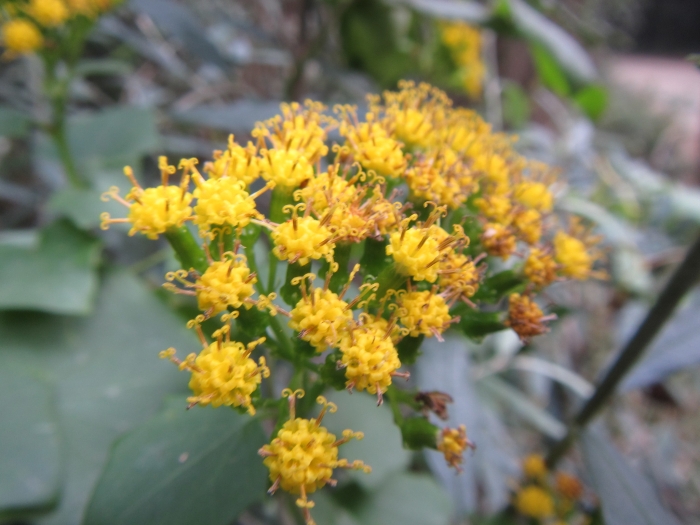Cape Ivy
(Delairea odorata)
Cape Ivy (Delairea odorata)
/
/

douglaseustonbrown
CC BY-SA 4.0
Image By:
douglaseustonbrown
Recorded By:
Copyright:
CC BY-SA 4.0
Copyright Notice:
Photo by: douglaseustonbrown | License Type: CC BY-SA 4.0 | License URL: http://creativecommons.org/licenses/by-sa/4.0/ | Rights Holder: douglaseustonbrown | Publisher: iNaturalist | Date Created: 2019-06-19T13:18:28-07:00 |












Estimated Native Range
Summary
Delairea odorata, commonly known as Cape ivy or German ivy, is a perennial, herbaceous climbing plant native to the Eastern Cape of South Africa. It thrives in forest margins and ravines, often at elevations above 4921 feet (1500 meters) in the Drakensberg Mountains. Cape ivy typically grows up to 10 feet tall, with glossy, semi-succulent leaves that are 1-4 inches long and wide, arranged alternately along the stems. Its sweet-scented, yellow discoid flowers are modest in size and bloom mostly during winter to early spring, providing a splash of color in the cooler months.
Cape ivy is valued for its rapid growth and lush foliage, making it popular for indoor hanging baskets, green walls, and as a ground cover in shaded areas. However, its aggressive growth habit requires regular pruning to keep it under control. It prefers partial to full shade, moist but well-drained soil, and moderate watering. While it can be a beautiful addition to the garden, Delairea odorata is extremely invasive outside its native range and can smother native vegetation. Before planting it, gardeners should check local regulations and consider its potential to escape cultivation.CC BY-SA 4.0
Cape ivy is valued for its rapid growth and lush foliage, making it popular for indoor hanging baskets, green walls, and as a ground cover in shaded areas. However, its aggressive growth habit requires regular pruning to keep it under control. It prefers partial to full shade, moist but well-drained soil, and moderate watering. While it can be a beautiful addition to the garden, Delairea odorata is extremely invasive outside its native range and can smother native vegetation. Before planting it, gardeners should check local regulations and consider its potential to escape cultivation.CC BY-SA 4.0
Plant Description
- Plant Type: Herb, Vine
- Height: 3-10 feet
- Width: 3-10 feet
- Growth Rate: Rapid
- Flower Color: Yellow
- Flowering Season: Spring, Winter
- Leaf Retention: Evergreen
Growth Requirements
- Sun: Full Sun, Part Shade
- Water: Medium
- Drainage: Medium
Common Uses
Low Maintenance, Potted Plant
Natural Habitat
Native to forest margins and ravines in the Eastern Cape of South Africa
Other Names
Common Names: Cape Ivy, Climbing Groundsel, German Ivy, Italian Ivy
Scientific Names: , Delairea odorata, Delairea scandens, Senecio mikanioides, Senecio mikanioides,
GBIF Accepted Name: